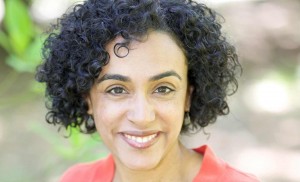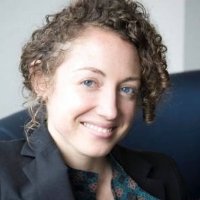This is edited excerpt from a Sustainable Business Fridays conversation held April 27 by the Bard MBA in Sustainability program in New York City. This twice-monthly dial-in conversation features sustainability leaders. The previous interview was with Maria Seddio of CorpTalk and Wash!.
 Yerina Mugica is the managing director of National Resource Defense Council’s Center for Market Innovation. The CMI is team of private sector-trained, market-focused professionals within NRDC, a nonprofit dedicated to using law, science and a large membership network to catalyze environmental action.
Yerina Mugica is the managing director of National Resource Defense Council’s Center for Market Innovation. The CMI is team of private sector-trained, market-focused professionals within NRDC, a nonprofit dedicated to using law, science and a large membership network to catalyze environmental action.
CMI works to accelerate the shift from centralized industrial-scale production to more sustainable, distributed solutions that offer both strong profit potential and better outcomes for people and the planet.
Bard MBA: Can you tell us a little bit about what led you down your path and how your career has evolved?
Yerina Mugica: In terms of my background, I would say I started with mainstream business. I was a business undergrad and I had a goal to get a good job when I graduated with a good salary that would allow me to support myself and help my family. I started out in consulting on financial systems and then moved to working as director of product development for an Internet startup.
Through those experiences, I found that I really enjoyed working in the business space but I wanted to find a way to combine my business background with my passion for making a more positive impact in the work that I do. So I decided to go back and get an MBA with a focus on sustainability in 2002.
At that time, only a handful of schools had that kind of focus. I went to UNC Chapel Hill, which had a program that focused on sustainable enterprise along with the traditional MBA. Along the way in that MBA program, I had the opportunity to be exposed to what, for me, was a whole new world around nonprofits as a sector.
Through a number of engagements and partnerships through the MBA program, I had the opportunity to work at an NGO and through those experiences I realized that working at an NGO allowed me to focus 100 percent of my time on work that I found really valuable and value-aligned.
It also allowed me to take a step back and look across an entire sector and think about what are the barriers that are preventing it from moving forward in a more sustainable way? So when I graduated, I decided to pursue the non-profit sector.
I was fortunate enough to meet someone working at NRDC as director of programs. I started talking to him about what I was doing and how I thought that there were opportunities to build upon the power of markets to create powerful change. He basically said, “Well, that’s interesting because NRDC’s been thinking about starting a center around those concepts and we could use some help in thinking that through.”
So I jumped into this consulting role where I helped to conceptualize what a center for market innovation could look like, and it took a few years to get that up and running.
In the meantime I also worked on local policies here in New York City, for example on the hybrid taxi bill and a bill around electronic waste, and I also worked at the federal policy level on energy efficiency. When we did launch the Center for Market Innovation 2007, I was able to move into that space and pursue collaborative opportunities with the market.
I had also built up a better understanding of how policy and business can work together and how they can complement each other. I’m especially thinking about enabling business as the way that we move forward with shifting to a greener economy and a greener environment.
Bard MBA: Can you tell a little more about the work that the Center for Market Innovation does?
Mugica: Our goal at the Center for Market Innovation is to help accelerate the shift to a greener, more prosperous economy that benefits everyone. On the ground we work collaboratively with the private sector as well as public sector and other NGOs to help identify opportunities, demonstrate, support and then scale up strategies that really deliver those profitable solutions.
For example, one of the areas that we have worked on is an initiative called the High Performance Tenant Demonstration Project, where we are working with commercial tenants to help bring the business case for energy efficiency into their decision-making process when they’re moving into a new commercial space.
We do this type of partnership across energy, shelter, water and food, which are the four key areas that we focus on. These are the building blocks of life. They are also areas where we see opportunities for really transformative environmental markets.
Bard MBA: Can you tell us more about the partnerships you forge with for-profit and non-profit actors to forge these markets?
Mugica: I think our work in green infrastructure is a great example. This is an area where we have partnered with a number of entities to address the problem of stormwater runoff.
We worked with the city of Philadelphia to help think through strategies to bring the private sector investment into the space and help accelerate their ability to reduce problems related to their stormwater overflow and increase their green infrastructure. We also worked in that same partnership with EKO Private Asset Management as well as The Nature Conservancy to analyze and assess opportunities.
The great part of the story is there are tremendous amounts of opportunity in this space. In fact, there are much more cost effective ways to address stormwater runoff through green infrastructure than through only investing in more traditional routes such as rebuilding stormwater processing facilities that are extremely expensive for cities and don’t necessarily provide all the additional benefits that you get from green infrastructure. We’ve been able to work with these partners to identify a path to increasing investment in green infrastructure at the same time reducing the cost the city would need to comply with its stormwater regulations.
This approach happens to have the benefit of providing more green space and greater economic opportunity within the city as well.
Bard MBA: Given your experience, what do you think are the key elements of a successful, collaborative partnership?
Mugica: That’s a great question. The first thing is having a clear shared mission and having clearly defined roles for what each partner brings to the table. From the starting point, make sure we’re all aligned and moving toward the same goal. There are going to be times where the partners don’t agree on everything, so focusing in on what is the goal of the partnership, and making sure that we do agree on that goal and on the strategy for moving it forward, is a critical first step. For us, that’s been shown time and time again in the partnerships that we form.
Bard MBA: What are you most looking forward to with the work that you’re doing at CMI and your sustainability career in general?
Mugica: There’s a lot of exciting stuff that is coming up. One of those includes that we are moving toward an approach that is much more integrated. Instead of looking at each of these areas — food, shelter, energy and water — independently, we’re looking at taking a more integrated approach. So, working on revitalization by bringing together more affordable housing with more green space that addresses stormwater issues as well, or incorporating improving access to healthy food as part of the definition of a sustainable community.
Just taking a more holistic approach is an exciting approach as we move into more projects.
